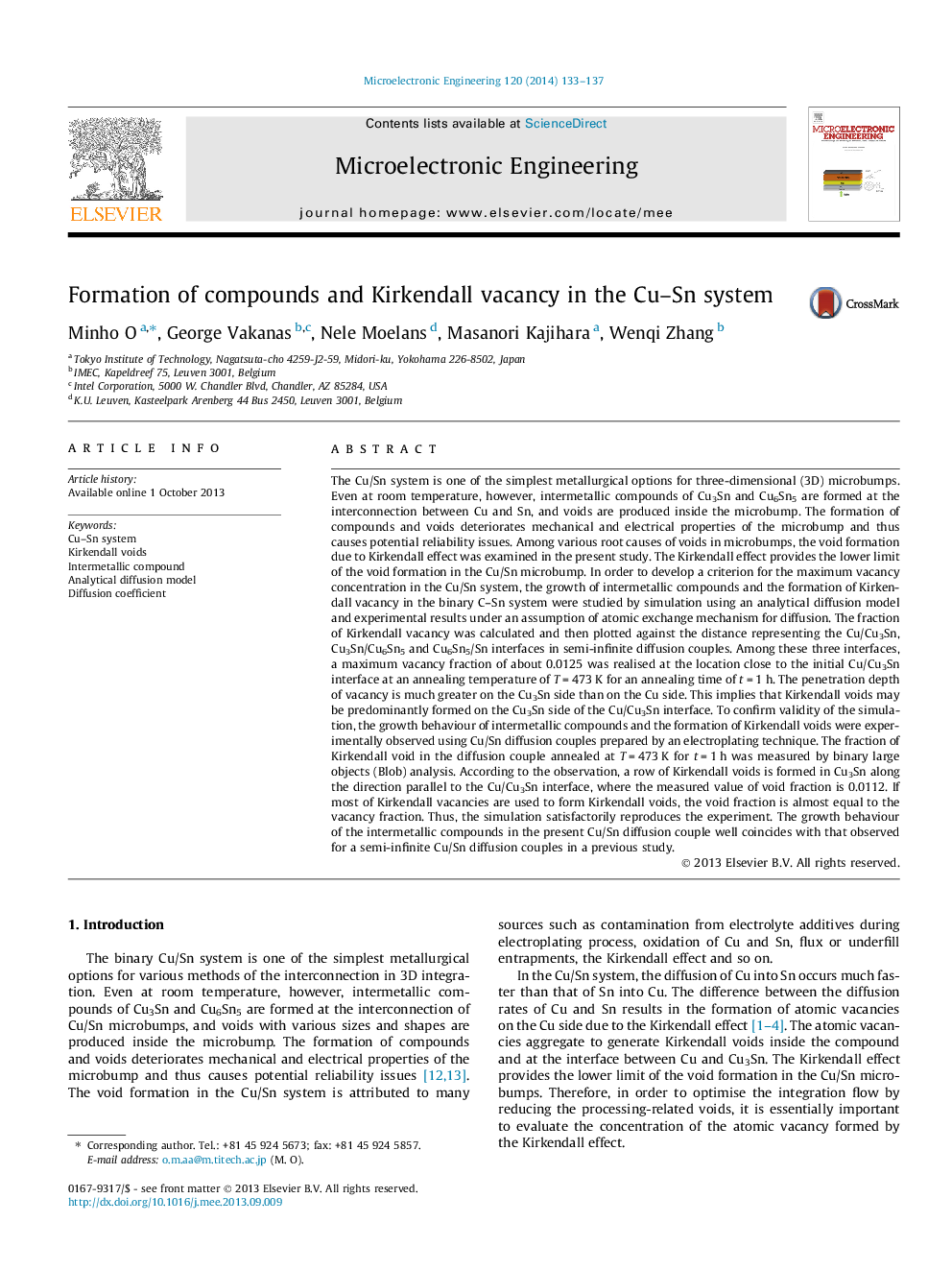| کد مقاله | کد نشریه | سال انتشار | مقاله انگلیسی | نسخه تمام متن |
|---|---|---|---|---|
| 541320 | 1450361 | 2014 | 5 صفحه PDF | دانلود رایگان |

• The Kirkendall effect provides the lower limit of the void formation in the Cu/Sn.
• A criterion for the maximum vacancy concentration in the Cu/Sn system was developed.
• The fraction of Kirkendall vacancy was calculated by an analytical diffusion model.
• Kirkendall voids were experimentally observed using Cu/Sn diffusion couples.
• The simulation result satisfactorily reproduces the experiment.
The Cu/Sn system is one of the simplest metallurgical options for three-dimensional (3D) microbumps. Even at room temperature, however, intermetallic compounds of Cu3Sn and Cu6Sn5 are formed at the interconnection between Cu and Sn, and voids are produced inside the microbump. The formation of compounds and voids deteriorates mechanical and electrical properties of the microbump and thus causes potential reliability issues. Among various root causes of voids in microbumps, the void formation due to Kirkendall effect was examined in the present study. The Kirkendall effect provides the lower limit of the void formation in the Cu/Sn microbump. In order to develop a criterion for the maximum vacancy concentration in the Cu/Sn system, the growth of intermetallic compounds and the formation of Kirkendall vacancy in the binary C–Sn system were studied by simulation using an analytical diffusion model and experimental results under an assumption of atomic exchange mechanism for diffusion. The fraction of Kirkendall vacancy was calculated and then plotted against the distance representing the Cu/Cu3Sn, Cu3Sn/Cu6Sn5 and Cu6Sn5/Sn interfaces in semi-infinite diffusion couples. Among these three interfaces, a maximum vacancy fraction of about 0.0125 was realised at the location close to the initial Cu/Cu3Sn interface at an annealing temperature of T = 473 K for an annealing time of t = 1 h. The penetration depth of vacancy is much greater on the Cu3Sn side than on the Cu side. This implies that Kirkendall voids may be predominantly formed on the Cu3Sn side of the Cu/Cu3Sn interface. To confirm validity of the simulation, the growth behaviour of intermetallic compounds and the formation of Kirkendall voids were experimentally observed using Cu/Sn diffusion couples prepared by an electroplating technique. The fraction of Kirkendall void in the diffusion couple annealed at T = 473 K for t = 1 h was measured by binary large objects (Blob) analysis. According to the observation, a row of Kirkendall voids is formed in Cu3Sn along the direction parallel to the Cu/Cu3Sn interface, where the measured value of void fraction is 0.0112. If most of Kirkendall vacancies are used to form Kirkendall voids, the void fraction is almost equal to the vacancy fraction. Thus, the simulation satisfactorily reproduces the experiment. The growth behaviour of the intermetallic compounds in the present Cu/Sn diffusion couple well coincides with that observed for a semi-infinite Cu/Sn diffusion couples in a previous study.
Figure optionsDownload as PowerPoint slide
Journal: Microelectronic Engineering - Volume 120, 25 May 2014, Pages 133–137